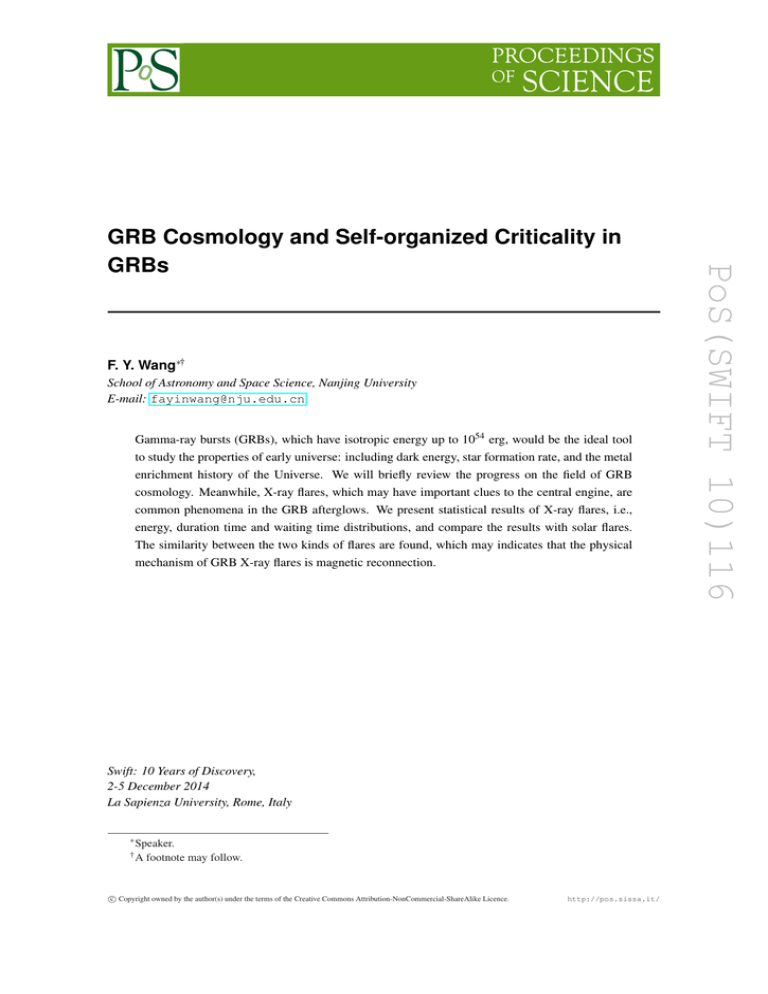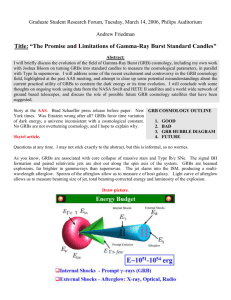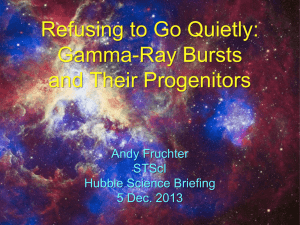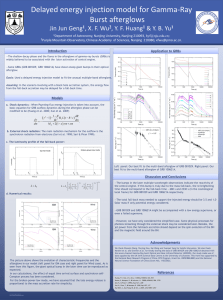PoS(SWIFT 10)116
advertisement

F. Y. Wang∗† School of Astronomy and Space Science, Nanjing University E-mail: fayinwang@nju.edu.cn Gamma-ray bursts (GRBs), which have isotropic energy up to 1054 erg, would be the ideal tool to study the properties of early universe: including dark energy, star formation rate, and the metal enrichment history of the Universe. We will briefly review the progress on the field of GRB cosmology. Meanwhile, X-ray flares, which may have important clues to the central engine, are common phenomena in the GRB afterglows. We present statistical results of X-ray flares, i.e., energy, duration time and waiting time distributions, and compare the results with solar flares. The similarity between the two kinds of flares are found, which may indicates that the physical mechanism of GRB X-ray flares is magnetic reconnection. Swift: 10 Years of Discovery, 2-5 December 2014 La Sapienza University, Rome, Italy ∗ Speaker. †A footnote may follow. c Copyright owned by the author(s) under the terms of the Creative Commons Attribution-NonCommercial-ShareAlike Licence. ° http://pos.sissa.it/ PoS(SWIFT 10)116 GRB Cosmology and Self-organized Criticality in GRBs GRB Cosmology and SOC in GRBs F. Y. Wang 1. Introduction 2. Constraints on dark energy GRBs have been widely used to constrain dark energy. We use the calibrating method to standardize 151 long GRBs with Eiso − Ep correlation. Just as using Cepheid variables to standardize SNe Ia, the GRBs can be calibrated with SNe Ia. We use the latest Union 2.1 data. This method is also cosmological model-independent [16]. The full GRB data is separated into two groups. The dividing line is the highest redshift in SNe Ia Union 2.1 data, namely z = 1.414. The low-redshift group (z < 1.414) includes 61 GRBs, and the high-redshift group (z > 1.414) contains 90 GRBs. The left panel of Figure 1 shows the 1σ and 2σ constraints on the Ωm − ΩΛ plane. Adding the GRB data can give much more tighter constraints. We also use the nonparametric technique to constrain the uncorrelated equation of state (EOS) of dark energy w(z). The EOS is the most important parameters of dark energy. We apply the nonparametric method to a joint data set of the latest observations including SNe Ia, CMB from Planck and WMAP polarization, large scale structure, the Hubble parameter measurement and GRBs. The right panel of Figure 1 shows the evolution of uncorrelated EOS of dark energy, which is consistent with ΛCDM at the 2σ confidence level [17]. 3. Star formation rate The high-redshift star formation rate (SFR) is important in many fields in astrophysics. Direct SFR measurement is still out of reach by present instruments, particularly at the faint end of the galaxy luminosity function. Long GRBs triggered by the death of massive stars, provide a complementary technique for measuring the SFR. In order to test the GRB rate relative to the SFR, we must choose bursts with high luminosities, because only bright bursts can be seen at low and high-redshifts, so we choose the luminosity cut Liso > 1051 erg s−1 [18] in the redshift bin 0 − 4. 2 PoS(SWIFT 10)116 The accelerating Universe at the present epoch was discovered from the observation of type Ia supernovae (SNe Ia) [1, 2]. The cosmic accelerated expansion has also been confirmed by other observations, such as cosmic microwave background (CMB) [3], and large-scale structure (LSS) [4]. But the SNe Ia can only be detected at low redshifts, i.e., z < 2.0. Gamma-ray bursts (GRBs), as the most powerful explosions in the Universe [5, 6], can fill the gap between SNe and CMB. GRBs can serves as the complementary tools to measure dark energy and cosmic expansion [7, 8, 9, 10, 11, 12]. Long GRBs can be made “relative standard candles", using luminosity correlations that have been found in prompt and afterglow phases [9, 13, 14]. X-ray flares with short rise and decay times are discovered by Swift satellite. The isotropicequivalent energy of X-ray flares is from ∼ 1048 to 1052 erg. The occurrence times of X-ray flares range from a few seconds to 106 seconds after the GRB trigger. Until now, the physical origin of X-ray flares has remained mysterious, although some models have been proposed. Here we investigate the energy release frequency distribution, duration-time frequency distribution and waiting time distribution of GRB X-ray flares [15]. On the other hand, it is well known that solar flare is triggered by a magnetic reconnection process. So we will compare these two kind of flares. GRB Cosmology and SOC in GRBs F. Y. Wang 1.0 0.9 Flat Universe 0.8 1 WL SNe 0.7 w(z) 0 0.6 -2 GRB+SNe -3 0.4 0.0 0.0 0.1 0.2 0.3 0.4 0.5 0.2 0.4 0.6 0.6 0.8 1.0 1.2 1.4 redshift z Wm Figure 1: Left: 1σ and 2σ constraints on Ωm and ΩΛ from different data sets. The solid line shows the Ωk = 0 case. Right: Estimation of the uncorrelated dark energy EOS parameters at different redshift bins (w1 , w2 , ..., w10 ) from SNe Ia+BAO+WMAP9+H(z) data. The open points show the best fit value. The error bars are 1σ and 2σ confidence levels. The dotted line shows the cosmological constant. Adopted from [17]. This removes many low-redshift, low-Liso bursts that could not have been seen at higher redshift. The SFR can be estimated as hρ̇∗ iz1 −z2 Nzobs−z = 1obs 2 N1−4 R4 1 /dz δ dz dVcom 1+z (1 + z) ρ̇∗ (z) R z2 z1 /dz δ dz dVcom 1+z (1 + z) , (3.1) where Nzobs is the observed GRB counts, and δ = 0.5 [19]. The derived SFR from GRBs are 1 −z2 shown as filled circles in the left panel of Figure 2. Error bars correspond to 68% Poisson confidence intervals for the binned events. The high-redshift SFRs obviously decrease with increasing redshifts, although an oscillation may exist. We find that the SFR at z > 4.48 is proportional to (1 + z)−3 using minimum χ 2 method, which is shown as solid line in Figure 2. The right panel shows the optical depth τe due to the scattering between the ionized gas and the CMB photons. The WMAP nine-year data gives τe = 0.089 ± 0.014 [20], which is shown as the shaded region. So our GRB-inferred SFR can reproduce the CMB optical depth. 4. Pop III GRBs and metal enrichment Absorption lines on the spectra of bright background sources, such as, are main sources of information about the chemical properties of high-redshift universe [21]. We simulate the formation of first galaxy. When a GRB explodes, its light will go through the metal-polluted region, so absorption line will appear in the spectrum. We found that the metals in the first galaxies produced by the first supernova explosion are likely to reside in low ionization states (C II, O I, Si II and Fe II). The GRB afterglow travel through the polluted environment in the first galaxy. The metals will produce the metal absorption lines in the GRB spectrum, as shown in Figure 4. Because the 3 PoS(SWIFT 10)116 0.5 -1 GRB Cosmology and SOC in GRBs F. Y. Wang 0 10 0.14 (1+z) -3 0.12 -1 Mpc -3 ) 10 0.10 e (M yr -1 WMAP9 (Hinshaw et al. 2012) 0.08 -2 10 0.06 Hopkins & Beacom (2006) Bouwens et al. (2009,2011) Hopkins & Beacom (2006) fit -3 10 N =4000 f 0.04 SFR derived from GRBs N =4000 f eff N =4000 f total SFR esc esc =0.2 =0.3 =0.1 Robertson & Ellis (2012) -4 10 0 1 2 3 4 5 6 7 8 9 0.00 10 0 redshift z 5 10 15 20 25 30 redshift z Figure 2: The cosmic star formation history. The dashed line shows their fitting result. The filled circles are the SFR derived from GRBs in this work. Adopted from Wang (2014). (a) Figure 3: Possible explosion sites for Pop III bursts. Shown are the hydrogen number density and metallicity contours during the assembly of a first galaxy, averaged along the line of sight within the central ' 100 kpc (comoving), at z ' 16.4, closer to the virilization of the atomic cooling halo. Now, metals are being reassembled into the growing potential well of the first galaxy. The topology of metal enrichment is highly inhomogeneous, with pockets of highly enriched material embedded in regions with a largely primordial composition. Adopted from [22]. topology of metal enrichment could be highly inhomogeneous, so along different lines of sight, the metal absorption lines may show a distinct signature. The metal absorption lines, in terms of their flux density and corresponding equivalent widths, will be detectable in the near future, with the launch of the JWST. From Figure 4, we can distinguish whether the Pop III progenitor dies as PISN, or Type II supernova from the observation of Pop III GRBs spectrum [22]. 5. Self-organized criticality in GRBs Thanks to the rapid-response capability and high sensitivity of the Swift satellite, numerous 4 PoS(SWIFT 10)116 0.02 esc GRB Cosmology and SOC in GRBs F. Y. Wang -24 Type II SNe -25 10 -26 10 F -2 -1 -1 erg cm s Hz 10 -27 10 4 10 -24 VMS -25 10 -26 10 4 5 10 6 10 7 10 (Å) obs 10 Figure 4: The total GRB spectrum with the metal absorption lines at the reverse shock crossing time (t⊕ = 16.7 × (1 + 16.37)s). Adopted from [22]. 2 -4 10 1 10 -6 10 -8 10 0 10 -10 10 RHESSI solar flares N=11595 10 -1 10 1 10 -2 10 0 10 -3 10 -1 10 -4 10 solar flares: N=11595 GRB X-ray flares N=83 HXRBS solar flares N=2787 -12 b 0 10 2 occurrence rate -2 cm 2 10 -2 10 Cumulative number of GRB X-ray flares 0 10 s -1 10 a -50 Solar flare frequency (10 1 10 b -1 erg ) 10 a 10 3 3 10 X-ray flares of GRBs: N=83 -1 1 10 2 10 3 10 4 10 5 10 6 10 Solar flare energy (10 24 7 10 erg) 8 10 0 10 1 10 2 10 3 10 4 10 GRB X-ray flare energy (10 48 10 -2 10 5 10 -5 1 10 erg) 2 10 3 10 Total duration T(s) 10 4 10 -1 10 0 10 1 10 2 10 3 10 4 10 5 10 Total duration T(s) Figure 5: Left: Energy-release frequency distributions. a, The differential energy frequency distribution of solar hard X-ray flares. b, The cumulative energy distribution of GRB X-ray flares. The 83 GRB Xray flares are shown as black dots. The black curve gives the cumulative energy distribution N(> E) = 1−αE a + b[E 1−αE − Emax ] with αE ∼ 1.06 ± 0.15 for GRB X-ray flares. Right: Duration-time frequency distributions. a, The relation between the occurrence rate and duration time for solar flares. b, The relation between the occurrence rate and duration time for GRB X-ray flares shown as green dots. Adopted from [15]. unforeseen features have been discovered, one of which is that about half of bursts have large, latetime X-ray flares with short rise and decay times. The unexpected X-ray flares with an isotropicequivalent energy from 1048 to 1052 ergs have been detected for both long and short bursts. We find that X-ray flares and solar flares share three statistical properties: power-law frequency distributions for energies (left panel of Figure 5), durations (right panel of Figure 5), and waiting times, which can be explained by self-organized criticality (SOC) theory [15]. For a self-organized criticality (SOC) system [23, 24], owing to some driving force, subsystems will self-organize to a critical state at which a small perturbation can trigger an avalanche-like chain reaction of any size within the system. The two types of flares are driven by a magnetic reconnection process. 5 PoS(SWIFT 10)116 F -2 -1 -1 erg cm s Hz 10 GRB Cosmology and SOC in GRBs F. Y. Wang 6. Conclusions GRBs are promising tools for studying the properties of early Universe, including dark energy, star formation rate and metal enrichment history. In the future, the French-Chinese satellite Spacebased multi-band astronomical Variable Objects Monitor (SVOM) and JWST, have been optimized to increase the number of GRB and the synergy with the ground-based facilities. This will open a new window of the dark ages of the Universe. [1] A. G. Riess, et al., Observational Evidence from Supernovae for an Accelerating Universe and a Cosmological Constant, AJ, 116 (1998) 1009 [2] S. Perlmutter, et al., Measurements of Omega and Lambda from 42 High-Redshift Supernovae, ApJ, 517 (1999) 565 [3] S. Komatsu, et al., Seven-year Wilkinson Microwave Anisotropy Probe (WMAP) Observations: Cosmological Interpretation, ApJS, 192 (2011) 18 [4] D. J. Eisenstein, et al., Detection of the Baryon Acoustic Peak in the Large-Scale Correlation Function of SDSS Luminous Red Galaxies, ApJ, 633 (2005) 560 [5] B. Zhang, P. Meszaros, Gamma-Ray Bursts: progress, problems & prospects, IJMPA, 19 (2004) 2385 [6] F. Y. Wang, Z. G. Dai, E. W. Liang, Gamma-ray burst cosmology, New Astro. Rev., 67 (2015) 1 [7] Z. G. Dai, E. W. Liang, D. Xu, Constraining OmegaM and Dark Energy with Gamma-Ray Bursts, ApJ, 612 (2004) L101 [8] G. Ghirlanda, et al., Gamma-Ray Bursts: New Rulers to Measure the Universe, ApJ, 613 (2004) L13 [9] E. W. Liang, B. Zhang, Model-independent Multivariable Gamma-Ray Burst Luminosity Indicator and Its Possible Cosmological Implications, ApJ, 633 (2005) 611 [10] L. Amati, et al., Measuring the cosmological parameters with the Ep,i-Eiso correlation of gamma-ray bursts, MNRAS, 391 (2008) 577 [11] F. Y. Wang, Z. G. Dai, Weak gravitational lensing effects on cosmological parameters and dark energy from gamma-ray bursts, A&A, 536 (2011) A96 [12] F. Y. Wang, S. Qi, Z. G. Dai, The updated luminosity correlations of gamma-ray bursts and cosmological implications, MNRAS, 415 (2011) 3423 [13] L. Amati, et al., Intrinsic spectra and energetics of BeppoSAX Gamma-Ray Bursts with known redshifts, A&A, 390 (2002) 81 [14] G. Ghirlanda, G. Ghisellini, D. Lazzati, The Collimation-corrected Gamma-Ray Burst Energies Correlate with the Peak Energy of Their nuFnu Spectrum, ApJ, 616 (2004) 331 [15] F. Y. Wang, Z. G. Dai, Self-organized criticality in X-ray flares of gamma-ray-burst afterglows, Nature Physics, 9 (2013) 465 [16] N. Liang, W. K. Xiao, Y. Liu, S. N. Zhang, A Cosmology-Independent Calibration of Gamma-Ray Burst Luminosity Relations and the Hubble Diagram, ApJ, 685 (2008) 354 [17] F. Y. Wang, Z. G. Dai, Estimating the uncorrelated dark energy evolution in the Planck era, Phys. Rev. D, 89 (2014) 023004 6 PoS(SWIFT 10)116 References GRB Cosmology and SOC in GRBs F. Y. Wang [18] H. Yüksel, M. D. Kistler, J. F. Beacom, A. M. Hopkins, Revealing the High-Redshift Star Formation Rate with Gamma-Ray Bursts, ApJ, 683 (2008) L5 [19] F. Y. Wang, The high-redshift star formation rate derived from gamma-ray bursts: possible origin and cosmic reionization, A&A, 556 (2013) A90 [20] G. Hinshaw, D. Larson, E. Komatsu, et al., Nine-year Wilkinson Microwave Anisotropy Probe (WMAP) Observations: Cosmological Parameter Results, ApJS, 208 (2013) 19 [21] X. Fan, C. L. Carilli, B. Keating, Observational Constraints on Cosmic Reionization, ARA&A, 44 (2006) 415 [23] P. Bak, C. Tang, K. Wiesenfeld, Self-organized criticality-An explanation of 1/f noise, Phys. Rev. Lett., 59 (1987) 381 [24] P. Bak, C. Tang, K. Wiesenfeld, Self-organized criticality, Phys. Rev. A, 38 (1988) 364 7 PoS(SWIFT 10)116 [22] F. Y. Wang, et al., Probing Pre-galactic Metal Enrichment with High-redshift Gamma-Ray Bursts, ApJ, 760 (2012) 27


